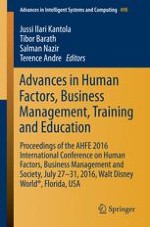2017 | OriginalPaper | Chapter
Incorporating Human Factors in Course Design: Utility of Wearable Technologies
Authors : Mohamed Ismail, Hamid Parsaei, Konstantinos Kakosimos
Published in: Advances in Human Factors, Business Management, Training and Education
Publisher: Springer International Publishing
Activate our intelligent search to find suitable subject content or patents.
Select sections of text to find matching patents with Artificial Intelligence. powered by
Select sections of text to find additional relevant content using AI-assisted search. powered by
